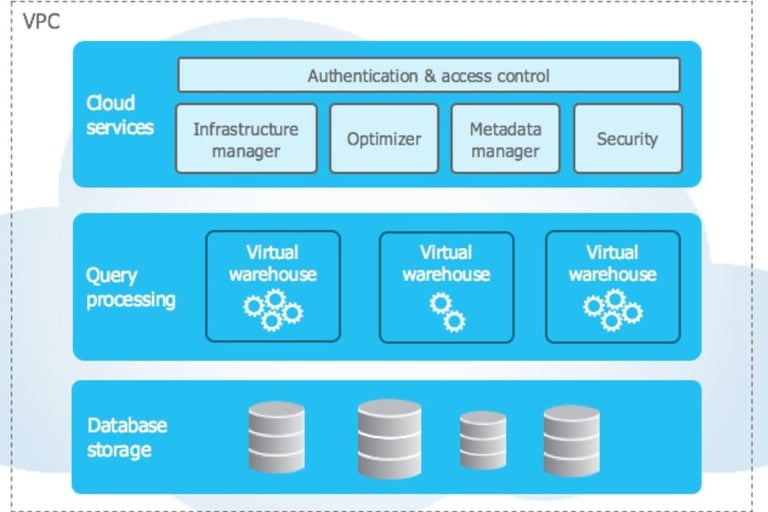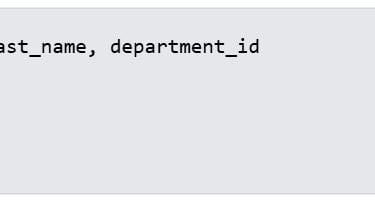Comprehensive Guide to Snowflake Architecture
This course provides a thorough exploration of Snowflake, a powerful cloud-based data warehousing solution. Participants will learn about Snowflake's unique architecture, understand its core components through detailed diagrams, and gain practical insights with simple explanations. Whether you're a beginner or looking to deepen your knowledge, this course will equip you with the skills needed to effectively utilize Snowflake for data management and analytics.
Sharath Natram
4/3/20257 min read

01 Introduction to Snowflake Architecture
Snowflake is a cloud-based data warehousing platform designed to handle diverse data workloads, from large-scale batch processing to quick, interactive queries. Its architecture is one of the key reasons for its performance, scalability, and ease of use. This architecture can be broken down into three primary layers: Database Storage, Compute, and Cloud Services.
Database Storage
At the foundation of Snowflake's architecture lies its Database Storage layer, which focuses on storing data efficiently.
Optimized for Storage: Snowflake uses a columnar storage format that compresses data effectively, reducing the overall size of the data while maintaining high performance. Each column can be compressed using various algorithms, optimizing both storage space and query speed.
Separation of Storage and Compute: One of the most significant aspects of Snowflake’s architecture is the decoupling of storage from compute. This design allows organizations to scale their storage and compute resources independently. For instance, if data volume increases, organizations can easily expand their storage without needing to increase compute power or vice versa.
Data Organization: Data in Snowflake is organized into databases, schemas, and tables. Snowflake automatically manages and optimizes the data to ensure efficient querying and storage.
SnowPipe for Continuous Data Loading: Snowflake's data ingestion tool, SnowPipe, facilitates near real-time data loading. This allows organizations to load data continuously from various sources, making it available for querying almost instantaneously.
Compute Layer
The Compute layer is where the actual processing of data occurs. Snowflake employs a unique multi-cluster architecture for this layer.
Virtual Warehouses: Snowflake utilizes "virtual warehouses" for executing queries and performing data manipulations. Each virtual warehouse operates independently, allowing multiple workloads to run concurrently without impacting performance. Depending on the computational demand, users can scale the size of the virtual warehouses up or down.
Multi-Cluster Architecture: Several virtual warehouses can be clustered together to handle varying workloads. If one warehouse is overloaded while others are underutilized, Snowflake can automatically balance the load across clusters. This ensures efficient resource usage, optimally catering to peak demands without any bottlenecks.
Elasticity: Snowflake provides an elastic compute model where resources can be added or removed dynamically based on workload requirements. This elasticity ensures that users only pay for the compute resources they actually use, promoting cost efficiency.
Cloud Services Layer
The Cloud Services layer is an overarching layer that manages different operational functions needed to provide a seamless and secure user experience.
Metadata Management: This layer handles all the metadata required for querying and data management. It keeps track of database objects, manages table schemas, and coordinates access controls, empowering users to manage their data efficiently.
Query Optimization: Snowflake’s automatic query optimization enhances performance by automatically rewriting queries for efficiency, leveraging statistics and metadata to generate optimal query execution plans.
Security: Snowflake employs advanced security protocols, including end-to-end encryption, to safeguard data both in transit and at rest. Features like role-based access control ensure that users only see the data they are authorized to access.
Data Sharing: Snowflake allows users to securely share data across different accounts and organizations seamlessly. This feature enhances collaboration without duplicating data, significantly reducing the complexity of data sharing.
Snowflake Architecture
To better visualize Snowflake's architecture, consider the following simplified diagram that highlights its three primary layers:


This diagram showcases how each layer interacts within Snowflake's structure, providing a clear picture of the platform's design and functionality.
Snowflake’s unique architecture consists of three key layers:
Database Storage
Query Processing
Cloud Services
Database Storage
When data is loaded into Snowflake, Snowflake reorganizes that data into its internal optimized, compressed, columnar format. Snowflake stores this optimized data in cloud storage.
Snowflake manages all aspects of how this data is stored — the organization, file size, structure, compression, metadata, statistics, and other aspects of data storage are handled by Snowflake. The data objects stored by Snowflake are not directly visible nor accessible by customers; they are only accessible through SQL query operations run using Snowflake.
Query Processing
Query execution is performed in the processing layer. Snowflake processes queries using “virtual warehouses”. Each virtual warehouse is an MPP compute cluster composed of multiple compute nodes allocated by Snowflake from a cloud provider.
Each virtual warehouse is an independent compute cluster that does not share compute resources with other virtual warehouses. As a result, each virtual warehouse has no impact on the performance of other virtual warehouses.
Cloud Services
The cloud services layer is a collection of services that coordinate activities across Snowflake. These services tie together all of the different components of Snowflake in order to process user requests, from login to query dispatch. The cloud services layer also runs on compute instances provisioned by Snowflake from the cloud provider.
Services managed in this layer include:
Authentication
Infrastructure management
Metadata management
Query parsing and optimization
Access control
Snowflake employs a unique architecture that separates compute from storage. This architecture consists of three main layers:
Database Storage: Snowflake automatically manages data storage, using a columnar format optimized for both performance and storage efficiency. Data is stored in scalable cloud storage, enabling rapid scaling without physical hardware limitations.
Compute Layer: This layer consists of virtual warehouses, which are independent clusters that execute queries. Multiple virtual warehouses can operate concurrently, allowing users to run different queries without impacting the performance of others. Each warehouse can be resized or suspended independently, providing cost efficiency and scaling flexibility.
Services Layer: The services layer includes various services such as query parsing, optimization, and security management. It handles user authentication, access control, transaction management, and system monitoring.
Data Management Concepts
Data Loading
Loading data into Snowflake can be accomplished through various methods, including:
Bulk Loading: Data files can be loaded in bulk from cloud storage services (e.g., Amazon S3, Azure Blob Storage). Snowflake uses the COPY command to read data directly from these sources.
Continuous Data Loading: Data integration tools (like Talend, Informatica, or Stitch) can be employed to continuously stream data into Snowflake. This method is useful for real-time analytics.
Manual Loading: Smaller datasets can also be inserted directly into Snowflake tables using traditional SQL INSERT commands.
Data Types
Snowflake supports a wide array of data types including:
Scalar Types: Such as INTEGER, STRING, BOOLEAN, DATE, and TIME.
Semi-structured Types: Including VARIANT, OBJECT, and ARRAY that allow handling of semi-structured data formats like JSON, Avro, and Parquet.
Geospatial Types: For storing and querying geographic data, supporting versatile geospatial functions.
Data Organization
Data in Snowflake is logically organized into schemas, which are collections of tables and other database objects. This organization facilitates easier data querying and management. Each table consists of rows and columns and can be accompanied by constraints such as primary keys, foreign keys, and unique constraints for data integrity.
Data Governance and Security
Snowflake offers robust data governance features, enabling organizations to manage access control and protect sensitive data effectively:
Role-Based Access Control (RBAC): Users are assigned roles that determine their access to different objects in a Snowflake account. This granular access control enhances security and ensures only authorized users can access specific data.
Data Masking: Sensitive data can be masked to ensure that unauthorized users cannot see it, even if they have access to the underlying database structure.
Data Auditing: Snowflake maintains a detailed history of all database activities, enabling organizations to track changes and maintain compliance with data governance policies.
Querying in Snowflake
SQL Support
Snowflake uses a variant of SQL as its query language. The SQL syntax in Snowflake encompasses standard SQL functions alongside several unique features tailored for analytic workloads, such as:
Window Functions: Enabling advanced analytics by performing calculations across a set of rows related to the current row.
CTE (Common Table Expressions): Simplifying complex queries by breaking them down into reusable subqueries.
User-Defined Functions (UDFs): Supporting custom functions that allow users to extend SQL capabilities with JavaScript or SQL.
Query Performance Optimization
Snowflake's architecture is inherently designed for performance efficiency. Key optimizations include:
Automatic Result Caching: Snowflake caches the results of queries and returns cached data for identical queries without executing them again, significantly improving response times.
Query Optimization: Snowflake’s query optimizer analyzes queries and generates an efficient execution plan. This optimization is automatic and does not require manual intervention.
Data Sharing and Collaboration
Snowflake allows for easy data sharing between different Snowflake accounts and external stakeholders while maintaining control and security. This capability supports various data collaboration and sharing scenarios without friction or complex extraction processes.
Example Query
A typical SQL query in Snowflake might look as follows:
This query retrieves employee details joined on specified criteria.
The simplicity of the SQL constructs combined with Snowflake's architecture ensures a seamless querying experience.


Snowflake Architecture Overview.
Create a presentation summarizing the key components of Snowflake's architecture, including the cloud services layer, data storage, and compute layers. Explain how these components interact with one another and their significance in data processing.
Evaluate Multi-Cloud Capabilities.
Research and compare Snowflake's deployment in different cloud environments (AWS, Azure, Google Cloud). Identify the advantages and disadvantages of using Snowflake on each platform. Prepare a report highlighting your findings with use cases for businesses considering multi-cloud strategies.
Hands On SQL-Query Exercises.
Using a Snowflake trial account, write and execute a series of SQL queries to manage a sample dataset. Include tasks such as data loading, creating tables, inserting records, updating records, and performing complex queries. Document each step and the results obtained.
Summary
>In summary, understanding the basics of Snowflake architecture sets the foundation for leveraging its powerful features in modern data management.
>Snowflake's multi-cloud infrastructure offers unparalleled flexibility and scalability, enabling businesses to optimize their data strategies across various cloud platforms.
>Efficient data management and querying in Snowflake empower users to harness data analytics effectively, leading to informed decisions and enhanced business outcomes.


QUIZ
Which feature of Snowflake enhances data sharing capabilities across different organizations?
(a) Data Cloning
(b) Data Sharing
(c) Data Replication
Which component of Snowflake handles the execution of queries and processing of data?
(a) Storage Layer
(b) Compute Layer
(c) Cloud Services Layer
What is the main benefit of using Snowflake's Multi-Cloud Infrastructure?
(a) Reduced Complexity
(b) Increased Flexibility
(c) Lower Costs
What type of data storage does Snowflake primarily use?
(a) Object Storage
(b) Block Storage
(c) File Storage
What is the main feature of Snowflake Architecture that allows for the separation of storage and compute resources?
(a) Single-Cloud Architecture
(b) Multi-Cloud Infrastructure
(c) Hybrid Architecture
In Snowflake, which method can be used for managing and transforming data before querying it?
(a) Materialized Views
(b) Indexed Views
(c) Dynamic Views
